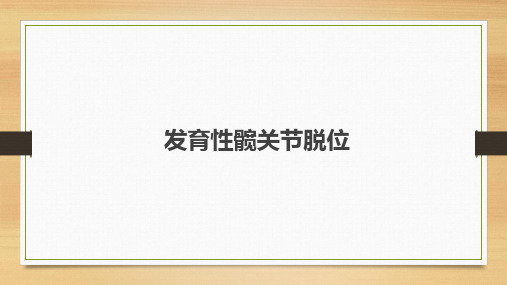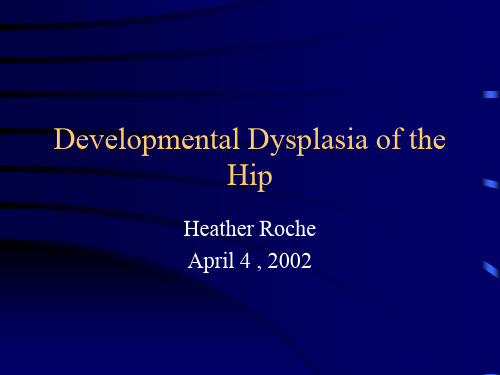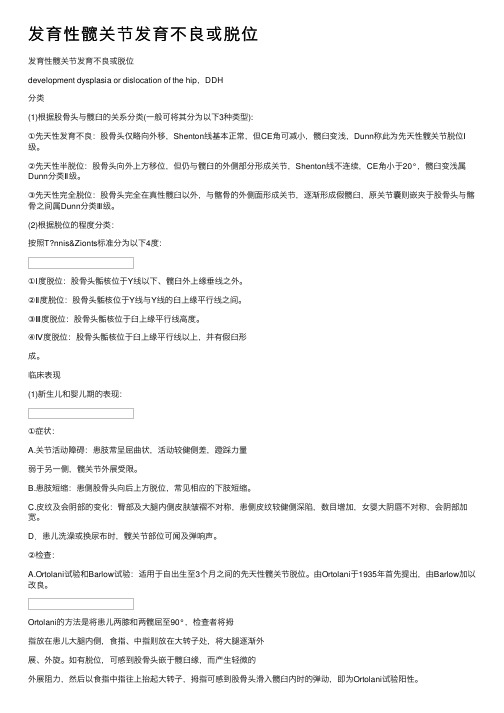133-发育性髋关节脱位(英文)
发育性髋关节发育不良髋脱位

(Developmental Dislocation/Displasia of the Hip, DDH)
内容
概述 流行病学 病理生理 分类 病因(危险因素) 临床表现 辅助检查 诊断及鉴别诊断 治疗
概述
✓ 1832年 Guillaume Dupuytren首次提出先天性 髋脱位(Congenital
✓ 辅助检查:
✓ 指导:
小儿骨折特点及处理原 则
流行病学
✓ 20%外伤的儿童发生骨折 ✓ 儿童时期42% 的男孩和27%的女孩
有骨折病史 ✓ 最常发生的部位: 桡骨远端,肘关节
,锁骨和胫骨干
儿童骨骼特
✓ 板层骨少
✓ 骨膜厚 血运丰富
✓ 管状骨的一端或两端有
危险因素
胎位 遗传因素 女孩 第一胎 激素
其他相关因素
生后体位 关节松弛症
与其他畸形伴发
足畸形
肌性斜颈
分类
髋臼发育不良 髋关节半脱位 髋关节脱位 (Dysplasia) (Subluxation) (Dislocation)
临床表现(新生儿)
Barlow Test Ortolani Test
3岁锁骨骨折
4年后复查完全塑形
肱骨髁上骨折
Supracondylar fracture of the humerus
✓ 肘关节最常见骨折 ✓ 占肘关节骨折50-60% ✓ 多见于4-10岁儿童
受伤机制
分型
✓ 根据骨折移位方向: 伸直型:90-95% 屈曲型:5%
✓ 根据骨折移位程度: I型: 无移位者 II型: 移位型
辅助检查
Normal
Torticolis
Ultrasound
发育性髋关节脱位DDH

骨盆平片测量法 a上方间隙 b内侧间隙
髋臼指数:
从髋臼外缘向髋臼中 心连线与H线相交所 形成的锐角。 (20°~25°),步 行后减小,12岁时15 °
复习基本概念 1.Perkin象限:
Perkin象限:两侧髋 臼中心(y形软骨) 连一直线,称为H线, 再从髋臼外缘向H线 做垂线(p),将髋 关节分为四个象限。
Von-Rosen摄片法
2、骨盆平片测量法(Bertol法):两侧髋臼Y型软骨连线为H线(Hilgenereiner线),所上端与H线 之间的距离为上方间隙,股骨上端鸟嘴与坐骨支外缘的距离为内侧间隙。正常值前者9.5mm后者 4.3mm。诊断标准,可疑髋关节脱位——上方间隙<8.5mm,内侧间隙>5.1mm;髋关节脱位—— 上方间隙<7.5mm,内侧间隙>6.1mm。
第七章 诊断与鉴别诊断
一、高危婴儿 为早期发现本病,提出DDH的高危婴儿,应详细检查,提高诊断率:
1、臀位产婴儿; 2、具有家族史; 3、具有某些先天性疾病,如,马蹄那翻足,斜颈; 4、持续性皮纹不对称 5、关节及韧带过度松弛。
二、确诊要点
1、新生儿仔细检查肢体的长短和Ortolani试验,阳性即可确诊。 2、开始行走不难诊断。 3、常规X线片、B超可协助诊断。 三、鉴别诊断
1、先天性髋内翻:步态跛行,患肢短缩,屈髋自如,外展受限,Allis征阳性,Trendelenburg征 阳性。X线颈干角明显变小,股骨颈近股骨头内下方有一三角形骨块,大转子高位。
2、病理性髋脱位:新生儿或婴儿期发生髋部感染的历史,X线见股骨头骨骺缺如。 3、麻痹性脱位:明显肌肉萎缩,肌力降低,尤其是臀肌肌力减弱,X线示半脱位。 4、痉挛性髋脱位:有早产窒息史,上神经元损伤表现。 5、多发性关节挛缩症合并髋关节脱位:畸形性型髋关节脱位,为双侧。
发育性髋关节脱位--内蒙古医学院

特别要仔细检查肢体的长短和Ortolani 试验,若为阳性即可确诊,并常规 拍摄X线片,也可配合B超检查,诊断 并不难,到儿童已能步行,则诊断更易。 7. 鉴别诊断: 7.1 先天性髋内翻。 7.2 病理性髋脱位。 7.3 麻痹性或痉挛性髋脱位:前者多为婴儿 麻痹后遗症,后者多为早产儿或生后窒 息者及有脑病史者。 7.4 多发性关节挛缩症合并髋关节脱位。
2.病理: 主要改变是脱位后的继发性变化, 如髋臼浅,前倾角大等,是符合“头臼 同心是髋关节发育的先决条件”的Harris 定律。随着年龄增长,病理改变日益加 重,此点位动物实验所证实,它间接的 证明本病不是先天性的。 髋臼:髋臼前、上、后缘发育不良,平坦, 变浅,其中脂肪组织、圆韧带充塞其中。 最终脱位的股骨头压迫髂骨翼出现凹陷, 假臼形成。
8. 治疗: 8.1 保守治疗:保守治疗的理论是Harris定 律,既头臼同心是髋关节发育的基本条 件。特别年龄小,发育速度快,且在一 定的时间内恢复至正常状态。关节运动 更能刺激髋关节发育,其中股骨头髋臼 发育更快。基于这一原理,为取得理想 复位,复位后维持髋关节的稳定性至关 重要。实现髋关节复位必须具备以下条 件:
脱位的分度标志着脱位的高低, 对手术前牵引方法的选择,治疗后 合并症的发生以及预后均有直接关 系。 畸形型:均为双侧髋关节脱位,双膝 关节处于伸直位僵硬,不能屈曲, 双足手呈极度外旋位,为先天性关 节挛缩症。有合并并指、缺指、拇 内收畸形。该型治疗困难,疗效不 佳,均需手术治疗。
4.临床检查: 倘若每个新生儿生后均能做常 规检查,在3~7天内明确诊断而进行 治疗,其疗效最理想。1岁内明确诊 断,可成功治疗,日后X线检查可 完全正常,说明早期诊断的重要性。
8.2.2 过头牵引复位法: 是通过持续牵引,髋关节逐渐外展, 而自然复位的方法,其优点是不需要全 麻下复位,可避免手法复位对股骨头的 创伤而导致股骨头缺血性坏死。其缺点 需较长时间的住院牵引。适应6个月以下、 脱位Ⅲ度或有较重的内收肌挛缩、应用 Pavlik 支具失败者,但也考虑用于1岁以 上的患儿。四个步骤:水平牵引、垂直 牵引、过头牵引、外展牵引而复位。
发育性髋关节脱位

一、发育性髋关节脱位
发育性髋关节脱位(develepmental dislocation of the hip,DDH),过去称为先天性 髋关节脱位(congenital dislocation of the hip),又有人称之为先天性髋关节发育不良 (congenital displasia of the hip),主要是髋臼、股骨近端和关节囊等均存在发育缺陷而 致关节不稳,直至发展为髋关节脱位。发病率0.1%~0.4%不等,不同的种族、地区发病 情况差别很大。女多于男,约为6∶1。左侧比右侧多,双侧者也不少见。
髋臼发育不良
髋关节半脱位
髋关节脱位
发育 Dysplasia Low dislocation
High dislocation
Crowe分类
TypeⅠ
<50% subluxation
Type Ⅱ
50%~75% subluxation
Type Ⅲ
髋关节屈曲外展试验
(1)双下肢不等长,左大腿内侧皱褶增加,左臀部呈现凹陷状 (2)屈膝、屈髋外展试验左侧阳性,右侧正常
Allis征:左侧膝关节低于健侧(右)
除此以外还需检查以下几项: ①跛行步态:单侧脱位时跛行,双侧脱位表现为“鸭步”,臀部明显突出; ②Nelaton线:髂前上棘与坐骨结节连线称为Nelaton线,正常时此线通过大转子顶点,脱 位时大转子在此线之上; ③Trendelenburg试验:嘱患儿单腿站立,另一腿尽量屈髋屈膝,使足离地。正常时对侧骨 盆上升,脱位后股骨头不能托住髋臼,臀中肌无力,使对侧骨盆下降,从背后观察尤为 清楚,称为Trendelenburg征阳性,是髋关节不稳的体征。
骨盆截骨术治疗
(1)Salter骨盆截骨术;(2)Chiari骨盆内移截骨术
(医学课件)发育性髋关节脱位演示课件

2023发育性髋关节脱位演示课件CATALOGUE目录•概述•临床表现•检查和诊断•治疗•预防•展望01概述定义发育性髋关节脱位(Developmental Hip Dislocation,DHD)是一种较为常见的髋关节疾病,因髋关节周围韧带松弛、髋关节囊前壁发育缺陷导致股骨头失去正常支撑,长期处于脱位状态。
诊断标准根据患者症状、体格检查和影像学检查进行诊断。
通常认为,站立位状态下,股骨头与髋臼外上缘之间的距离大于或等于4mm,可诊断为发育性髋关节脱位。
定义和诊断标准发育性髋关节脱位在女婴中的发病率高于男婴,约为1.5:1。
发生率发育性髋关节脱位是一种遗传性疾病,家族史阳性者占20%~35%。
该病的发生还与胎位、胎儿大小、羊水多少等因素有关。
流行病学发生率和流行病学发病机制发育性髋关节脱位的发病机制尚不明确,目前认为可能涉及遗传、内分泌、机械等多种因素。
病理生理发育性髋关节脱位患者的髋臼浅而平,股骨头失去正常支撑,向外上方移位。
长期脱位可导致股骨头发育不良、变形甚至坏死,严重影响患者生活质量。
发病机制和病理生理02临床表现1症状和体征23发育性髋关节脱位患者常表现为髋关节不稳定,尤其是在运动时。
髋关节不稳定患者的步态可能会出现异常,例如摇摆、内外八字等。
步态异常随着病情发展,患者可能会出现臀中肌和臀小肌的萎缩,表现为臀部两侧不对称。
肌肉萎缩03学龄前期和学龄期学龄前期和学龄期的患者可能已经出现明显的步态异常和双下肢不等长的情况。
不同年龄段患者的表现01新生儿和婴儿期新生儿和婴儿期的患者常表现为髋关节不稳定,臀部两侧不对称,大腿短缩、内收、内旋畸形。
02幼儿期幼儿期的患者除了上述表现外,还可能出现步态异常、双下肢不等长等情况。
并发症及其表现骨关节炎随着病情发展,患者可能会出现骨关节炎,表现为关节疼痛、活动受限等症状。
神经损伤在某些情况下,患者可能会出现坐骨神经损伤,表现为大腿后侧和小腿外侧的麻木、肌肉萎缩等症状。
发育性髋关节脱位--gai

流行病学
• 1.先天性因素:白种人发病率高,黑种人低。 2.遗传因素:20%家族史,80%为第一胎。
3.内分泌因素:80~90%女孩,我国男:女=1:4.75,雌激
素。 4.胎位:臀位产=10头位产,剖腹产>阴道顺产。 5.生活习惯、环境因素:背背婴儿,发病率低;寒带及冬 季出生者,发病率高;预防措施:保持髋关节外展位。
病理变化
• 圆韧带:脱位后圆韧带改变不一,部分病 例拉长、增宽和肥厚。部分病例可局部消 失或完全消失。
先天性髋关节脱位的主要病理特点
• ①髂腰肌紧张、挛缩,压迫髋臼的入口; • ②关节囊变形呈葫芦样; • ③股骨头颈变形,主要有股骨头呈椭圆形, 股骨颈短,股骨颈前倾角增大; • ④髋臼变形,主要有髋臼窝浅小,呈三角 形,髋臼指数增大,关节盂唇内卷; • ⑤股圆韧带增粗变长,关节软骨变性等。
CE角:中心边
缘角,即过股骨 头中心点的yy” 垂线,髋臼外缘 与股骨头中心点 的连线所形成的 夹角。髋臼发育 不良或半脱位。 (<20 °)
Shenton线:正常闭
孔上缘弧形线与股骨 颈内侧弧形线相连在 一个抛物线上。脱位 时此线消失。
基本概念
AHI:髋
臼对股骨 头的覆盖 情况。 AHI=A/B ×100.正常 值84~85.
病理变化
软组织变化:严重程度与年龄、脱位高度成 正比。 • 盂唇:胚胎六周,髋臼和股骨头之间由间 质细胞连接而出现间隙,中间的间质细胞 逐渐吸收,形成关节腔。任何刺激使间质 细胞停止吸收,即出现盂唇。胚7~8周, 关节囊、髋臼盂缘形成。 盂唇过度增大、内翻可阻碍复位,尤其 合并头臼不称时,常常复位失败。。
临床表现及检查
• 较大儿童的检查 除上述体征及外展试验尚需以下检查: 1.跛行步态 单侧脱位—跛行,双侧脱位—鸭步,臀部后突。
133发育性髋关节脱位英文

• includes congenital dislocation and developmental hip problems including subluxation, dislocation and dysplasia
Developmental Dysplasia of the Hip
Heather Roche April 4 , 2002
• Previously known as congenital dislocation of the hip implying a condition that existed at birth
• 11wk hip joint fully formed
• acetabular growth continues throughout intrauterine life with development of labrum
• birth femoral head deeply seated in acetabulum by surface tension of synovial fluid and very difficult to dislocate
Normal Growth and Development
• Embryologically the acetabulum, femoral head develop from the same primitive mesenchymal cells
• cleft develops in precartilaginous cells at 7th week and this defines both structures
发育性髋关节脱位

病理变化(2)
C、股骨颈:可变短变粗。 颈干角:增大。 前倾角:正常新生儿25~35度,随年龄逐渐减小。 脱位后肌肉收缩使头向前旋转,前倾角变大。 前倾角增大或颈干角加大(髋外翻),均造 成 DDH复位后不稳定性增加。
病理变化(3)
D、骨盆与脊柱:脱位侧骨盆常伴发育异常, 如:假臼形成、髋臼基底增厚、坐骨结节 分开、耻骨联合增宽等。 单侧脱位后骨盆发生倾斜、代偿性脊柱 侧弯出现,并随年龄加重。 双侧脱位腰椎前凸显著增加、臀部后翘、 骨盆较为垂直。
(3)
臼分成四个象限。
诊 断
CE角:股骨头骺中心 到髋臼外缘的连线,与 股骨头骺中心和Y-Y
(4)
线垂线之间的夹角。
正常人的最小值为 20度。
诊 断
(5)
二次骨化中心未出现前的DDH诊断依据:
髋臼指数增大
Shenton线中断
股骨颈内侧缘距泪点的距离增大(4.3-5.1mm)
股骨近端距离Y-Y线的垂直距离减小(8.5-9.5mm)
(1)
白种人1~2‰
◆我国:上海0.91‰
北京地区3.8‰
香港0.07‰
发病率
(2)
2、家族遗传因素: 约有20%的DDH病人具有家族史。 3、性别因素: 女孩占绝对优势,我国统计男女 之比为1:5。
发病率
(3)
4、地区与种族之间的发病率差异很大,这与遗传因
素、环境的影响以及生活习惯等有关。
如南非、中非有的民族以及我国南方人民习惯背婴儿, 这样婴儿的髋关节经常保持在屈曲、外展外旋位,DDH 的发病率显著降低。相反如意大利北方、德国有的民族及
四、病因
尚不明确。以多基因与多因素解释较合乎逻辑。
◆多基因指双亲中一方或双方存在几个异常活跃的基因,虽 在家族中无特殊分布模式,但可遗传,也可能为基因突变 的结果。 ◆多因素指胎位、季节、关节松弛等。臀位产发病率约为 16~30 ‰,秋冬季发病率高;吴守义统计DDH及正常儿 童各200例,DDH关节松弛占34~45%,正常只有8~12 %。
发育性髋关节发育不良或脱位

发育性髋关节发育不良或脱位发育性髋关节发育不良或脱位development dysplasia or dislocation of the hip,DDH分类(1)根据股⾻头与髋⾅的关系分类(⼀般可将其分为以下3种类型):①先天性发育不良:股⾻头仅略向外移,Shenton线基本正常,但CE⾓可减⼩,髋⾅变浅,Dunn称此为先天性髋关节脱位Ⅰ级。
②先天性半脱位:股⾻头向外上⽅移位,但仍与髋⾅的外侧部分形成关节,Shenton线不连续,CE⾓⼩于20°,髋⾅变浅属Dunn分类Ⅱ级。
③先天性完全脱位:股⾻头完全在真性髋⾅以外,与髂⾻的外侧⾯形成关节,逐渐形成假髋⾅,原关节囊则嵌夹于股⾻头与髂⾻之间属Dunn分类Ⅲ级。
(2)根据脱位的程度分类:按照T?nnis&Zionts标准分为以下4度:①Ⅰ度脱位:股⾻头骺核位于Y线以下、髋⾅外上缘垂线之外。
②Ⅱ度脱位:股⾻头骺核位于Y线与Y线的⾅上缘平⾏线之间。
③Ⅲ度脱位:股⾻头骺核位于⾅上缘平⾏线⾼度。
④Ⅳ度脱位:股⾻头骺核位于⾅上缘平⾏线以上,并有假⾅形成。
临床表现(1)新⽣⼉和婴⼉期的表现:①症状:A.关节活动障碍:患肢常呈屈曲状,活动较健侧差,蹬踩⼒量弱于另⼀侧,髋关节外展受限。
B.患肢短缩:患侧股⾻头向后上⽅脱位,常见相应的下肢短缩。
C.⽪纹及会阴部的变化:臀部及⼤腿内侧⽪肤皱褶不对称,患侧⽪纹较健侧深陷,数⽬增加,⼥婴⼤阴唇不对称,会阴部加宽。
D.患⼉洗澡或换尿布时,髋关节部位可闻及弹响声。
②检查:A.Ortolani试验和Barlow试验:适⽤于⾃出⽣⾄3个⽉之间的先天性髋关节脱位。
由Ortolani于1935年⾸先提出,由Barlow加以改良。
Ortolani的⽅法是将患⼉两膝和两髋屈⾄90°,检查者将拇指放在患⼉⼤腿内侧,⾷指、中指则放在⼤转⼦处,将⼤腿逐渐外展、外旋。
如有脱位,可感到股⾻头嵌于髋⾅缘,⽽产⽣轻微的外展阻⼒,然后以⾷指中指往上抬起⼤转⼦,拇指可感到股⾻头滑⼊髋⾅内时的弹动,即为Ortolani试验阳性。
发育性髋关节脱位手术治疗

手术过程演示
术前准备与Salter 手术相同
步骤1~10与Salter手术相同
步骤11 剥离髂骨外板骨膜至髋臼髂坐 软骨连接
手术方法演示
术前准备——股骨下段骨牵引
牵引前
牵引两周后
步骤1 手术切口
步骤2 保护股外侧皮神经
步骤3 切开髂嵴骨膜
步骤4 切断股直肌
步骤5 清理出关节囊
步骤6 切断髂腰肌腱
步骤7 关节囊切开线路
步骤8 关节腔切开
步骤9 切断股骨头韧带
步骤10 真臼内充填的软组织被清除
步骤11 剥离髂骨内外板骨膜至坐骨大切迹
根据年龄以及每个病儿髋关节病理 改变情况选择治疗方法,是提高疗效, 减少并发症的重要前提。复位以及维持 复位后的稳定性是治疗的基本要求。
治疗方法
闭合复位 通常用于2岁半以内病儿。
开放复位
用于2岁半以上才接受首次治疗的 病例或者2岁半以下闭合复位失败或不 宜于闭合复位的病例。
目前多数作者同意由于2岁半以后 病儿自身重塑发育不良的髋臼能力已很 有限,甚至在准确复位充分遵守术后处 理常规的情况下也是如此,这也是开放 复位后尚须进行种种髋关节重塑手术的 理论依据。
步骤12 直角弯钳自内向外穿过大切迹
步骤13 导入线锯自坐骨大切迹至髂前上下 棘间作外高内低斜形截骨
步骤14 近段髂骨切取等腰三角形骨块
步骤15 以耻骨联合为中心,将远折段连同 髋臼向前下外旋转移位后嵌入三角形骨块
步骤16 克氏钻钻孔后两枚可吸收棒做ห้องสมุดไป่ตู้固定
发育性髋关节发育不良

术后康复要点
术后康复要点
• 第二阶段:第4-6天 (患髋关节运动)
1.仰卧位直腿抬高运 动:
(主动为主,被动为 辅)抬高在30°以 内
2.仰卧位患肢夹枕内 收运动:两腿间夹 一软枕,主动夹腿
术后康复要点
• 第三阶段:第7天开始至14天(平卧位-侧卧-坐 位-站立-行走)
髋臼发育不良及关节韧带松弛 体位与机械因素
发病率
不同地区的发病率不同,中国北方地区的发病率高于 南方,华北地区的发病率为3.8%,华东地区为1.1%, 华南地区为0.7% 。男女之比约为1∶5~6 。
病理改变
表现为髋臼外上方和前方缺损,髋臼变 浅,髋关节中心外移,致使髋臼对股骨 头的包容与覆盖不足
定义
发育性髋关节发育不良(developmental
dysplasia of hip,DDH)传统诊断名称为先天性髋 关节脱位(congenital dislocation of the hip,CDH),1991年美国骨科学会(AAS)和北美小儿 骨科学会(POSNA)统一称之为发育性髋关节发育不 良发育性髋关节脱位。
• 1.平卧位至侧卧:翻身时一手托臀部,一 手托膝部,将患肢与身体同时转为侧卧,并在 两腿间垫上枕头,禁内收内旋。
术后康复要点
起床 • 2.卧位到坐位:
双手支撑坐起,屈 健腿伸患腿,利用 双手和健腿支撑力 将患肢移至小腿能 自然垂于床边。移 动健侧,坐在床旁 ,注意尽量保持患
术后康复要点
坐位 • 3.坐位到站位:训
术后康复要点
步行
• 4.站位到行走训 练(拄拐平地行走 患肢逐渐少量负重 ):拄拐,健腿先 向前迈进,患腿随 后,拐杖随后或同 时,患腿由不负重 到部分负重。
发育性髋关节脱位英文

Developmental Hip DysplasiaDevelopmental hip dysplasia (DHD), also known as developmental dysplasia of the hip (DDH), is a condition that affects the hip joint in infants and young children. It is a congenital disorder that occurs when the hip joint does not develop correctly.CausesThe exact cause of DHD is not known, but it is believed to be a combination of genetic and environmental factors. Some factors that may increase the risk of DHD include:•Family history of DHD•First-born child•Female gender•Breech presentation at birth•Swaddling too tightlySymptomsIn the early stages of DHD, there may not be any noticeable symptoms. However, as the condition progresses, symptoms may include:•Limited range of motion in the hip•Clicking or popping sounds in the hip joint•One leg appearing longer than the other•Difficulty crawling or walking•Favoring one side of the body while sitting or standing DiagnosisDHD is usually diagnosed during routine well-baby checkups. The doctor will perform a physical exam to check for signs of hip dysplasia. If the doctor suspects DHD, imaging tests such as an ultrasound or X-ray may be ordered to confirm the diagnosis.TreatmentThe goal of treatment for DHD is to position the hip joint correctly and to keep it stable, allowing for normal development of the hip joint. Treatment options depend on the age of the child and the severity of the condition. Some options include: •Pavlik harness: This is a soft brace that helps hold the hip joint in place. It is most effective in children under six months of age.•Spica cast: This is a type of cast that goes around the hips and legs to hold the hip joint in place. It is usually used in children over six months of age.•Surgery: If the above treatments are not effective, surgery may be necessary to correct the position of the hip joint.PrognosisEarly diagnosis and treatment of DHD can lead to a good outcome. Most children with DHD will not experience any long-term effects if they receive prompt treatment. However, in severe cases that go untreated, DHD can lead to arthritis and other hip problems later in life.PreventionWhile it is not always possible to prevent DHD, some measures can be taken to reduce the risk of it developing. These may include:•Avoiding tight swaddling•Encouraging tummy time to strengthen muscles and promote hip development•Using a baby carrier that spreads the legs to support the hip joints•Having regular well-baby checkups to monitor hip development ConclusionDevelopmental hip dysplasia is a common congenital disorder that affects the hip joint in infants and young children. Early diagnosis and treatment are important in preventing long-term complications. If you suspect your child may have DHD, it is important to speak with a healthcare professional.。
发育性髋关节脱位早期诊断

骨盆平片测量法 a上方间隙 b内侧间隙
二、婴儿及儿童
1、Perkin象限:于股骨头骨骺核骨化出现 后检测。从髋臼外缘向H线做一垂线(P), 将髋关节分为4个象限,正常时股骨头骨 骺位于内下象限,在外下象限为半脱位, 在外上象限为全脱位。
1、盂唇 2、关节囊 3、圆韧带 4、肌肉与筋膜
早期诊治的意义
研究表明成人髋关节骨化性炎症病因>50% 源自儿童期未被发现和未经治疗的髋关节 发育异常。DDH的早期诊断能够及时阻止 病变发展,减少晚期病例,而早期治疗方 法多,时间短,费用少,效果明显。Fra bibliotek 早期诊治模式
目标
早期诊断
出生3 个月内诊断确立
膝平面失衡
新生儿期检查方法
4、Barlow试验:是早期诊断的有效方法。 仰卧,双髋双膝各屈曲90°,拇指放在 大腿内侧小转子处加压,向外上方推压股 骨头,有股骨头从髋臼内滑出髋臼外的弹 跳。若去掉拇指压力,则股骨头又自然弹 回髋臼内,为Barlow试验(即弹出试验) 阳性。
注意操作技巧
Barlow test 检查髋关节稳定性
早期干预
采用自我运动或软器械促进髋关节发展
早期治疗
行走前的治疗
儿童保健医生
儿童骨科医生
DDH诊治状况比较
中国初诊时间:大城市6~12月, 中小城市 12~18月,农村1~3岁,山区>3岁。
发达国家初诊时间:出生~3月 中国治疗现状:(1) Pavlic吊带使用很少;
(2)主要是复位+石膏固定;(3)手术复 位方法繁多;(4)晚期病例常见。 发达国家治疗形状:(1)治疗多<1岁; (2)残余病例为主;(3)晚期病例极少。 目前我省的确诊平均时间已降至10~12月。
- 1、下载文档前请自行甄别文档内容的完整性,平台不提供额外的编辑、内容补充、找答案等附加服务。
- 2、"仅部分预览"的文档,不可在线预览部分如存在完整性等问题,可反馈申请退款(可完整预览的文档不适用该条件!)。
- 3、如文档侵犯您的权益,请联系客服反馈,我们会尽快为您处理(人工客服工作时间:9:00-18:30)。
• articular cartilage covers portion articulating with femoral head opposite side is a growth plate with degenerating cells facing towards the pelvic bone it opposes
• triradiate cartilage is triphalanged with each side of each limb having a growth plate which allows interstitial growth within the cartilage causing expansion of hip joint diameter during growth
• The cartilage complex is 3D with triradiate medially and cup-shaped laterally
• interposed between ilium above and ischium below and pubis anteriorly
Development cpn’t
• Experimental studies in humans with unreduced hips suggest the main stimulus for concave shape of the acetabulum is presence of spherical head
• 11wk hip joint fully formed
• acetabular growth continues throughout intrauterine life with development of labrum
• birth femoral head deeply seated in acetabulum by surface tension of synovial fluid and very difficult to dislocate
• acetabular cartilage forms outer 2/3 cavity and the non-articular medial wall form by triradiate cartilage which is the common physis of these three bones
• In the infant the greater trochanter, proximal femur and intertrochanteric portion is cartilage
• 4-7 months proximal ossification center appears which enlarges along cartilaginous anlage until adult life when only thin layer of articular cartilage persists
• normal growth and development occur through balanced growth of proximal femur, acetabulum and triradiate cartilages and the adjacent bones
DDH
• Tight fit between head and acetabulum is absent and head can glide in and out of acetabulum
• hypertrophied ridge of acetabular cartilage in superior, posterior and inferior aspects of acetabulum called “ neolimbus”
Normal Growth and Development
• Embryologically the acetabulum, femoralபைடு நூலகம்head develop from the same primitive mesenchymal cells
• cleft develops in precartilaginous cells at 7th week and this defines both structures
• developmental encompasses embryonic, fetal and infantile periods
• includes congenital dislocation and developmental hip problems including subluxation, dislocation and dysplasia
Developmental Dysplasia of the Hip
Heather Roche April 4 , 2002
• Previously known as congenital dislocation of the hip implying a condition that existed at birth
• for normal depth of acetabulum to increase several factors play a role – spherical femoral head – normal appositional growth within cartilage – periosteal new bone formation in adjacent pelvic bones – development of three secondary ossification centers
